Future accommodations

This archived material is for informational purposes only; the information provided was accurate at the time of publication but may no longer be current.
This latest report from Guardian's 11th Annual Workplace Benefits Study looks at the well-being of workers with disabilities and how employers can take steps towards inclusivity today.
Guardian Edge is your resource for the latest insights on workplace trends
The COVID-19 pandemic has transformed the way we work. And, for certain segments of the workforce, the advancements in flexibility, remote work accommodations, and enhanced leave offerings have contributed positively to overall well-being.1 Workers with permanent disabilities are among the segments who have benefited from these accommodations — some of which, workers with disabilities have been asking for from their employers for years.
Introduction
The past two years have had a tremendous impact on workforce well-being, touching mental, physical, and financial wellness. The adaptations made in response to the pandemic have uniquely impacted workers with disabilities. Insights from their experience can help inform workplace policies moving forward, especially as many employers consider returning to hybrid or in-person working arrangements, potentially undoing some advancements made towards supporting workers with disabilities.
The Americans with Disabilities Act (ADA) of 1990 prohibits discrimination based on disability to help ensure qualified people with disabilities have an equal chance of getting a job.2 It also requires covered employers to provide reasonable accommodations to workers with disabilities, such as modifications to schedules or their work environments.3 However, workers with disabilities across all age groups are much less likely to be employed than those without a disability, and are nearly twice as likely to work part time, pointing to remaining barriers to work and opportunities for employers to offer more robust accommodations and be more supportive and flexible.4
There are many reasons why companies should hire workers with disabilities. Organizations that hire people with disabilities benefit from improvements in loyalty and retention, competitive advantages like customer loyalty and satisfaction, innovation, and inclusive work culture.5 Moreover, companies that champion disability inclusion perform better financially than those that don’t.6 The findings from the past two years can help inform employers’ approaches to attracting and retaining workers with disabilities. By creating more inclusive workplace cultures, embracing the learnings from the pandemic, and applying these insights to their full workforce, employers will not only support workers with disabilities, they’ll support everyone.
About these findings
In this brief, Guardian focuses on data about US workers with a disability who are full-time employees with employee benefits. While this segment represents a minority of workers with a disability — and ones who are likelier to have higher overall well-being than others with a disability, according to our research — it is still an important demographic with takeaways around inclusivity for everyone.
Workers with disabilities today
A growing workforce segment
Workers with disabilities account for about 3% of the full-time US workforce, or more than 4 million people.7 In 2021, people with a disability accounted for 11.9% of the US population.8 Of those, about 3 in 10 work part-time.9 The employment rate among people with a disability has risen slightly over the past several years.10 Yet overall, individuals with a disability are much less likely to hold jobs than those with no disability.11
In 2022, full-time workers with disabilities are demographically similar to full-time workers without disabilities: they’re alike in age and close in income level, yet workers with disabilities are slightly less likely to hold a college degree and more than twice as likely to be a Veteran. These demographic similarities have increased since the start of the pandemic, in part due to increased access to remote work. Just two years prior, these demographics were notably different: workers with disabilities had lower household incomes (37% of workers with a disability versus 26% with no disability had an annual household income of less than $25K), 15% fewer workers held a college degree, and 15% more workers were 55 or older.
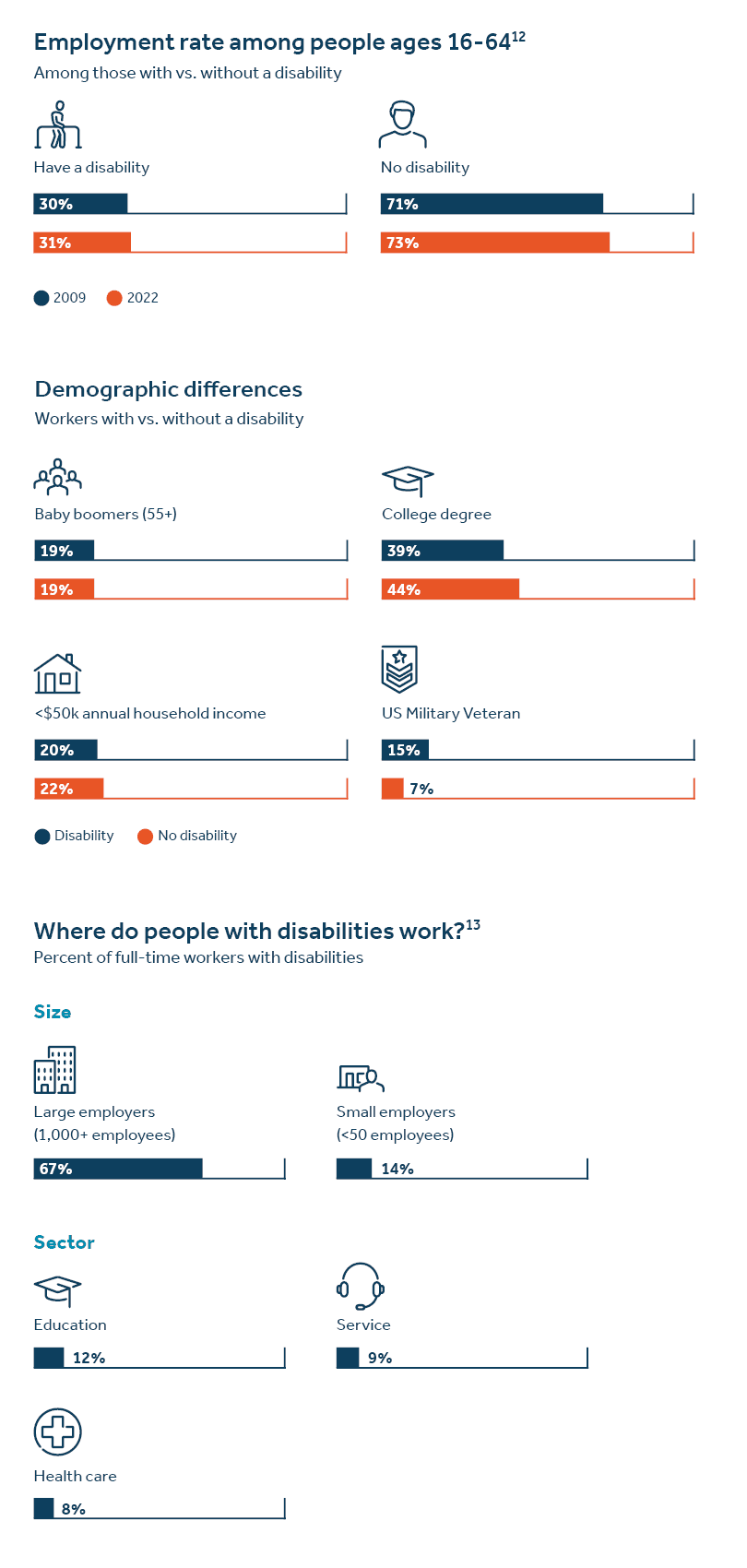
COVID-19 and workforce well-being
A workforce under pressure
More than 1 in 4 full-time workers say that COVID-19 negatively affected their emotional health over the past year and more than 2 in 5 report lower physical activity during the pandemic. The pandemic exacerbated challenges already facing certain members of the workforce, such as workers who relied on professional caregivers to tend to a sick or elderly relative and those already struggling with anxiety or depression.
In 2021 and 2022, COVID-19 was the leading cause of stress among all working Americans.
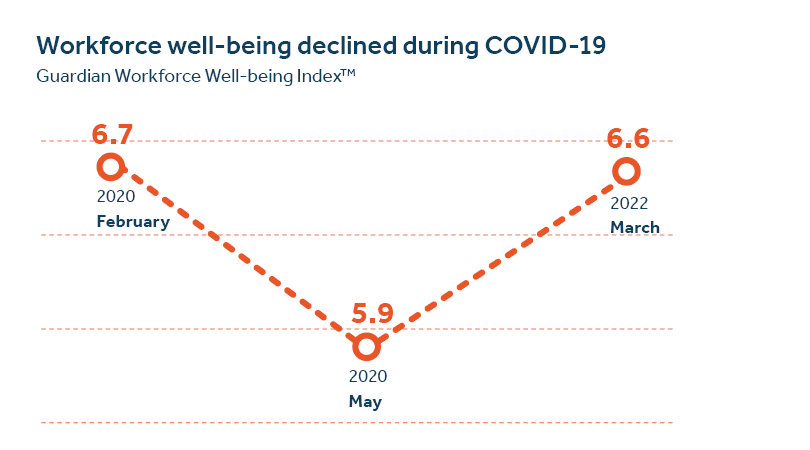
Half of the US workforce identified COVID-19 as their top source of stress, ranking it higher than other common life stressors such as money and finances, work responsibilities, health issues, and the economy. This was true across all demographics — low household income to high, married and single, Generation Z and baby boomers.
At the height of the pandemic, nearly 1 in 3 Americans lost their job, were laid off, had their hours reduced, or lost income due to the coronavirus. And this financial stress contributed to worsening mental and emotional stress. In fact, all dimensions of Guardian’s Workforce Well-being IndexTM declined in 2020 — including self-reported physical health.
The latest Workplace Benefits Study shows an uptick in overall well-being among full-time workers — improving across all three pillars of physical, emotional, and financial well-being. However, all Americans aren’t feeling this slight improvement equally. Only those who are working full-time jobs are experiencing the recovery. For those who are still underemployed or unemployed, many are still struggling with financial and emotional stress.
Well-being among workers with disabilities
Long before the pandemic, many employees with disabilities desired accommodations like remote work and greater flexibility to ease the challenges of working in-office, like long commutes or spaces that weren’t as accommodating as their homes. Therefore, for workers with disabilities, the pandemic brought some benefits. Moreover, for fully remote companies, having all employees remote created a more even playing field, where the virtual accommodations for work weren’t considered a one-off, but a company-wide necessity.
Bucking the trend: Well-being among workers with disabilities improved during the pandemic
Workers with a permanent disability have seen enhanced well-being from these accommodations: this segment showed improvements in well-being across all core pillars of emotional, physical, and financial wellness from 2018 to 2022. Reported physical well-being nearly doubled, with 30% of workers with a disability rating their physical well-being as “excellent/very good” in 2022 compared to only 16% in 2018.
Despite these improvements, workers with disabilities report lower well-being than other workers. Workers with disabilities are nearly twice as likely to experience anxiety or depression. Nearly half (48%) report experiencing anxiety, depression, or another mental health issue in the past year versus only one quarter (28%) of those without. Four in 10 workers with disabilities report that their mental health is a significant source of stress compared to just over 1 in 4 (26%) of workers without disabilities. People with permanent disabilities are more than twice as likely to be furloughed (12% versus 5%) or laid off (7% versus 3%) from their jobs than workers without disabilities.
The top stressors for workers with permanent disabilities were: COVID-19, money/finances, the economy, and work responsibilities. Moreover, workers with disabilities were more likely to cite their own mental health as a stressor (41% versus 26% of workers with no disability).
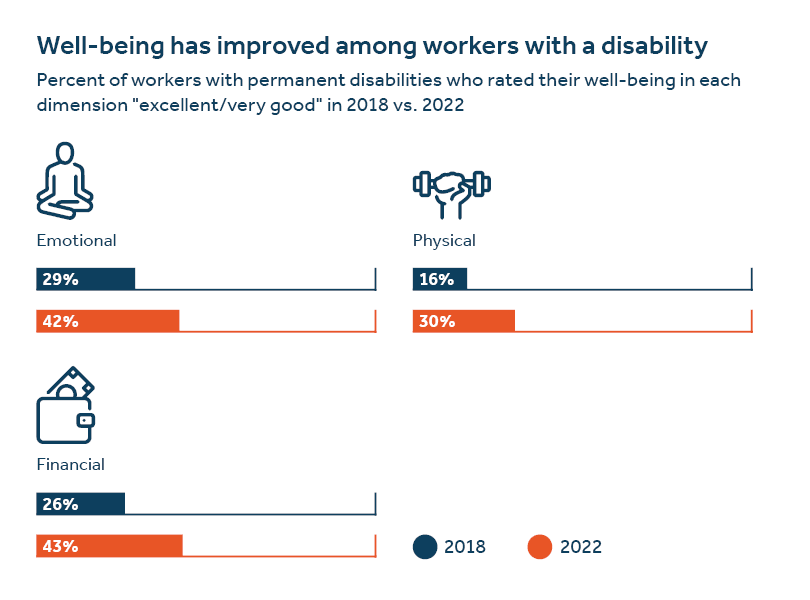
Attitudes towards employers and the workplace
In general, people with disabilities want to work, but given the push toward returning to physical workspaces, employers have room to improve in terms of offering equitable accommodations. There’s been a 19% increase from 2020 in employees with a disability who say their employer cares about their well-being. This finding is true for the wider population as well and points to the trend that more workers today feel their employers care about their well-being. There are a lot of factors that contribute to this increase, most notably the impact of the pandemic.
A focus on well-being
There was already a mental health crisis in America before the pandemic, but COVID-19 exacerbated it.14,15 Employers learned that supporting employee well-being required more than health insurance or a 401(k). Employers needed to find ways to support mental well-being, establish an open, empathetic environment, and foster dialogue around social issues or employee concerns. Guardian’s research has found that an emphasis on a healthy workplace culture has become a requirement for attraction and retention: employees want to work for organizations that care and are likelier to stay longer in their jobs when they feel supported.
Yet, there is still room to grow: less than half of workers with disabilities feel their workplace culture is flexible and empathetic.
More workers with disabilities strongly agree today than they did in 2020 that their employer cares about their overall well-being.
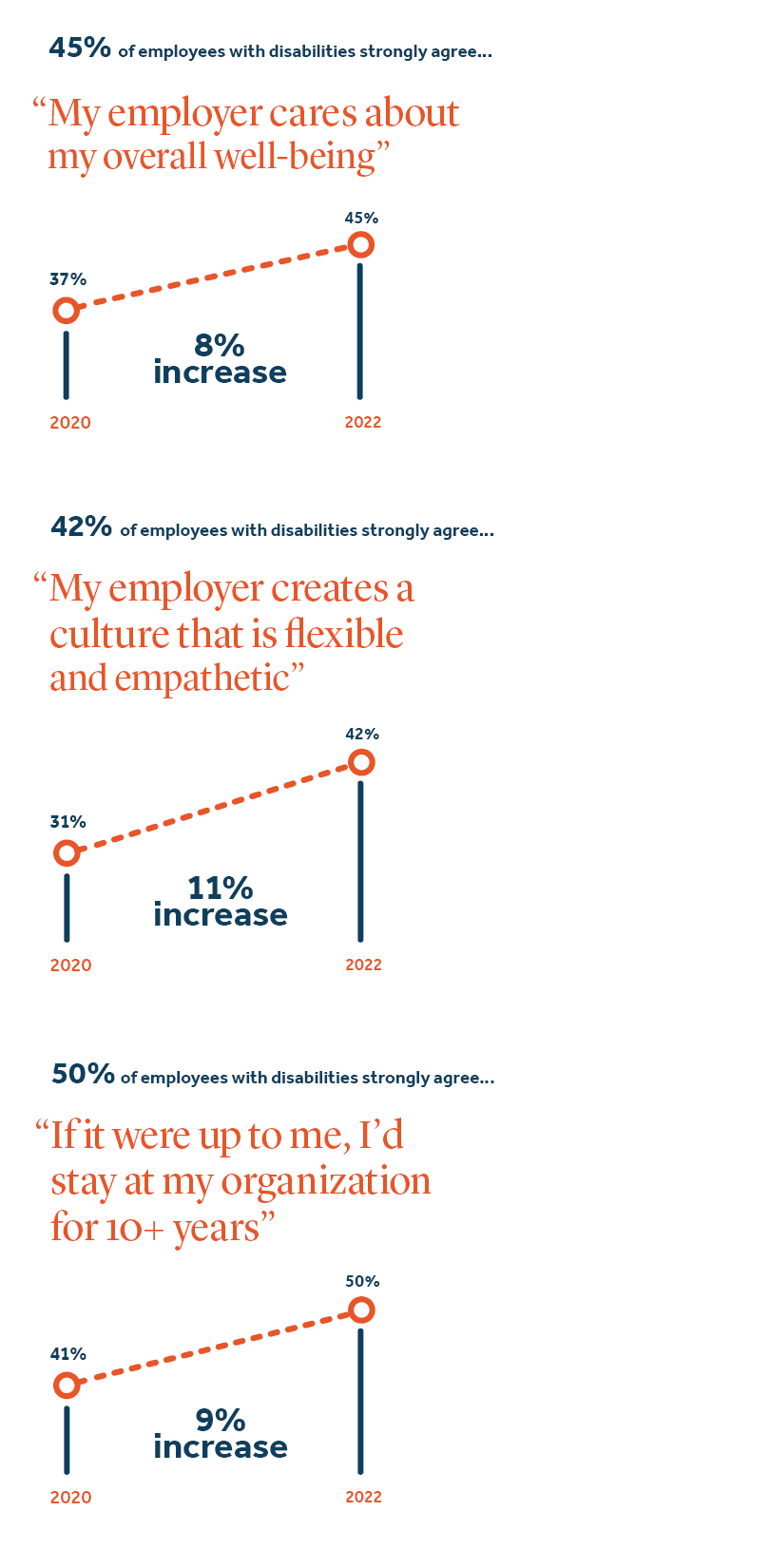
Enhanced loyalty
Workers with disabilities who do feel supported by their employer’s policies, culture, and environment are more loyal — to an even greater degree than most workers. Those who strongly agree that their employer is making adequate accommodations for workers with disabilities are twice as likely to prefer to stay with their employer for at least 10 years compared to those who do not feel supported (82% versus 43%).
What do workers with disabilities want and need?
While the accommodations of the pandemic such as remote work and flexible schedules have contributed positively, there are other key dimensions of workplace inclusivity for workers with disabilities.
An employer-employee disconnect
As employers work to build inclusivity, gaining awareness of how successful their efforts are is crucial. There’s a considerable perception gap as to how well organizations support workers with disabilities. Two-thirds (67%) of employers believe that their organization effectively supports and accommodates employees with disabilities. However, just over one-third (36%) of workers with a disability strongly agree.
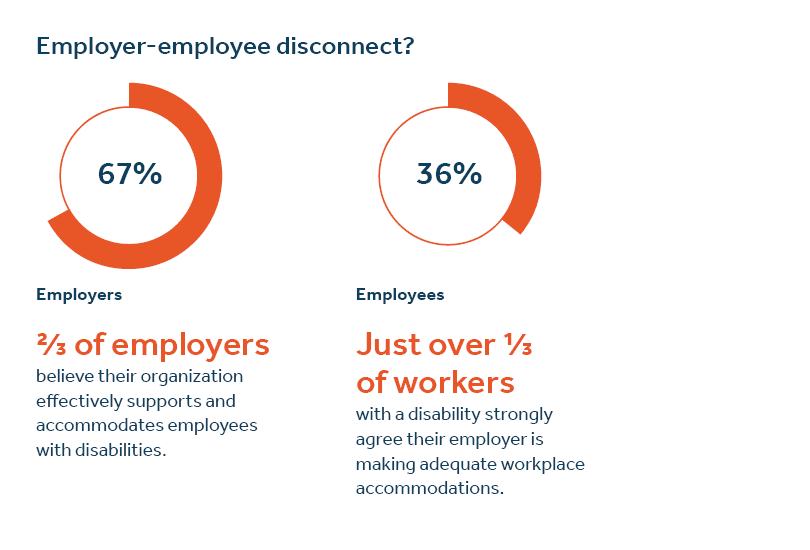
More inclusive benefits
People with disabilities rely more on workplace benefits for financial security than those without disabilities. More than half of workers with disabilities report that they live paycheck to paycheck compared to 4 in 10 workers without disabilities. Despite a great dependence on their benefits, fewer workers with disabilities report that their employer offers benefits that meet their personal needs.
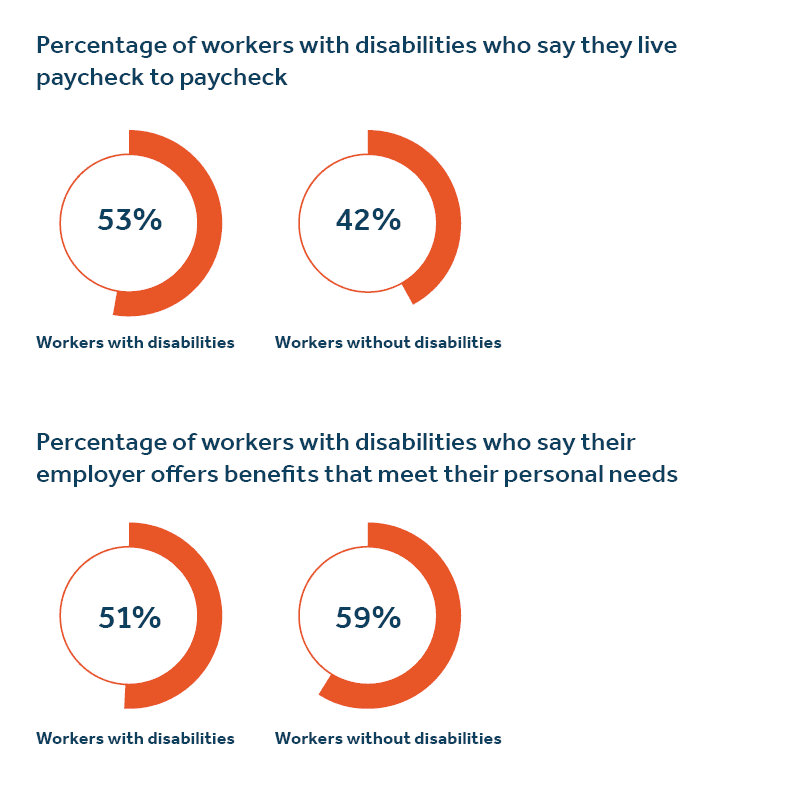
Leaning into pandemic learnings
There’s no one-size-fits-all approach when it comes to offering benefits and policies that meet the needs of workers with disabilities. Successful strategies, however, share a few similar components: planning, listening, and offering flexibility for all employees.
1. Develop a recruiting strategy
Only 1 in 8 employers have a designated strategy in place for recruiting workers with disabilities. Many companies are expanding their diversity and inclusion hiring strategies, and workers with disabilities are a key, intersectional part of any DEI initiative.16 Moreover, research demonstrates that, on average, more inclusive companies are twice as likely to have higher shareholder returns.17
2. Survey your employees
Actively listening to your employees about what worked and what didn’t during the pandemic can inform what changes can be made to help better meet the needs of employees with disabilities. By hearing employee feedback — and implementing changes based on what they hear — employers can help better meet their employees’ needs.
3. Offer flexibility for all
Implement flexible work policies for everyone — regardless of disability. By taking this approach, you ensure no one employee feels singled out. Employees shouldn’t feel isolated or ostracized by getting the things they need to succeed at work. Recognize that offering more accommodations and flexibility will help more people than you may expect. Many employers, for example, don’t account for employees with invisible disabilities and by offering flexibility and building an inclusive culture that supports everyone, an employee who may become disabled in the future could benefit by knowing they have an empathic employer.
An inclusive culture can lead to a loyal workforce. Many employees without disabilities appreciated some changes implemented during COVID-19 and, among employees who say their company handled COVID-19 well, nearly half (49%) say they’d like to stay at their company 10+ years compared to just 28% of those who say their companies handled it poorly. Three out of 4 employers changed their unpaid leave policies to paid during COVID-19, as a direct result of the pandemic. That policy not only helped people who needed to take leave but will also help others in the future.
When workplaces are more inclusive and there are policies and benefits in place to support the full range of how humans show up to work, that benefits everyone.
